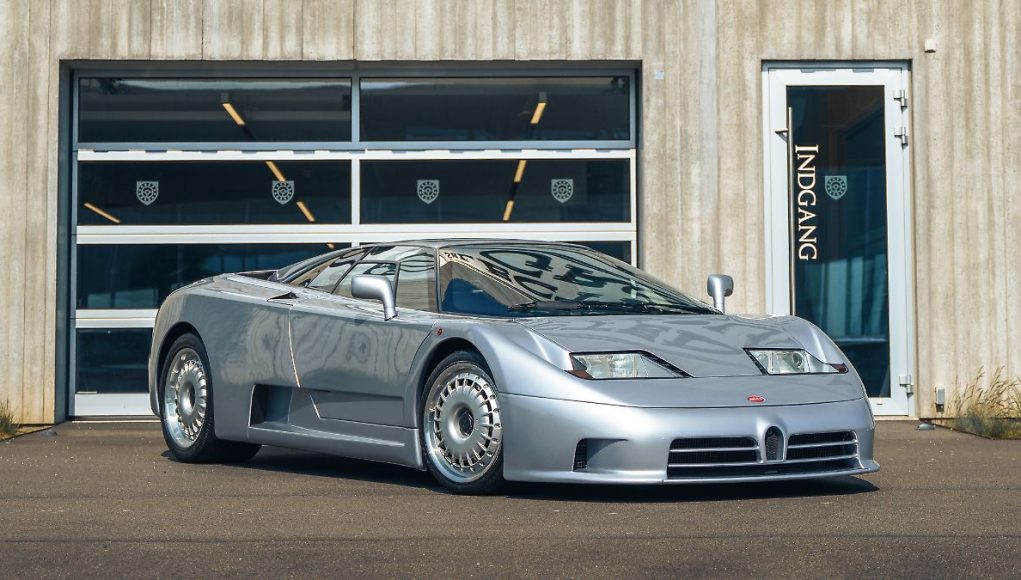In the 1990s, it hung as a poster in many teenagers' bedrooms, but it is very rare to see one on the street. Wherever the Bugatti EB110 appears, there are crowds of people. ntv.de took a ride with the exceptional sports car.
To be honest, the constant discussion about the prices of rare collector cars is annoying. Of course, certain rarities on wheels are extremely expensive and of course the owners use them as an investment. But the focus should of course be on the car and the fun of driving it. On the other hand, without the supercar brokers and car-savvy investment hunters, there would be fewer stories about crazy cars. And the Bugatti EB110 is definitely one such crazy car.
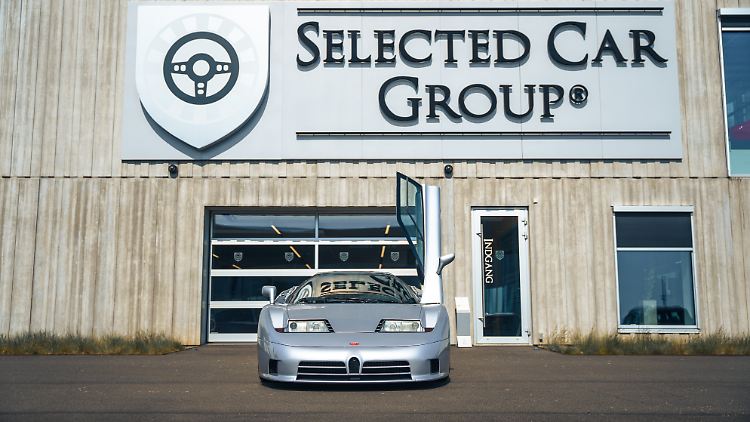

The front with the distinctive rectangular headlights is definitely the best side of the Bugatti EB110.
The Selected Car Group in Middelfart, near the German-Danish border, gave ntv.de an extensive test drive in the Bugatti rarity. And the team put a lot of effort into preparing it so that this example is not only beautiful to look at, but actually drives well too.
There are many exciting vehicles to see (and buy) here in Middelfart. It's worth the trip, even if you don't have a seven-figure sum of money lying around in your account. Similar to the Classic Remise and Motorworld locations of the world, the car center invites you to stroll around.
And in the catacombs of the large building on the extensive grounds, you can also have relatively mundane used models such as mid-size Mercedes SUVs shown to you. The trading group offers a complete package that gives Danes, who are plagued by high vehicle maintenance costs, the opportunity to use vehicles for a fixed monthly rate – there are various leasing options.
But international customers are also welcome and can dream about and buy cars here. The exhibition is more elegant, with various entry-level Ferraris, Lamborghini Huracáns and Porsche 356s (if you want oldies) competing for the best.
The EB110 outshines them all
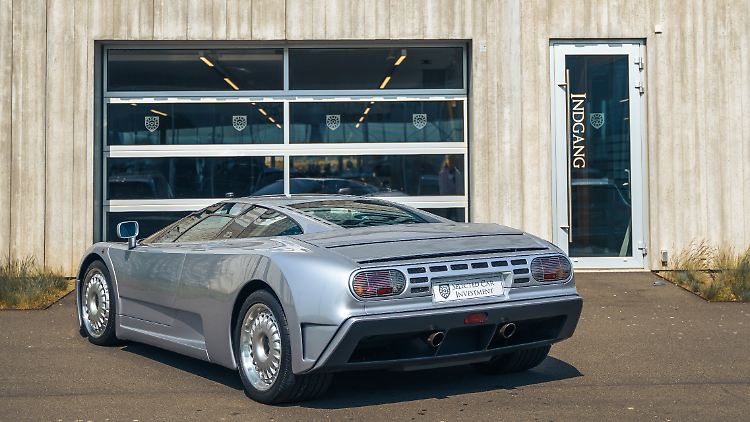

The rear of the ultra-flat sports car does not look as spectacular as the front.
(Photo: Patrick Broich)
But the exhibits can be as colorful as they want. There's no chance of competing with an EB110, even though the test model isn't in the typical blue, but in a more inconspicuous silver. Would you like a few specifications? All-wheel drive, four turbochargers, 3.5 liter displacement from twelve cylinders, five valves per cylinder and 560 hp are exactly the right ingredients for a recipe that, together with the right design, conjures up a spectacular dream car dish.
Speaking of blue. In 1987, entrepreneur Romano Artioli acquired the naming rights of the traditional Bugatti factory and had architect Giampaolo Benedini design the “Fabbrica Blu” and then build it in Campogalliano, near Modena. The entrepreneur was looking for proximity to concentrated Italian engineering – after all, Ferrari and Lamborghini were not far away. And because Artioli did not like the design of the star car designer Marcello Gandini for the EB110 (the name goes back to Ettore Bugatti's 110th birthday), Benedini was awarded the contract: You read that right, the architect responsible for the factory hall also designed the car as a side effect.
Bugatti was Italian for a short time
And because the French origins of the now Italian Bugatti Automobili SpA should also be honored in some way, the team around brand owner Romano Artioli organized a trip with 77 Bugattis from the pre-war era from Molsheim in Alsace to Campogalliano (over 600 kilometers of driving distance) on September 15, 1990 to inaugurate the factory, where Bugatti was founded and is now based again.
Unfortunately, the company was unable to survive. The first EB110 rolled out of the factory in 1991. But just four years later, the company closed down again after producing 128 examples of the EB110, which was based on a carbon fiber monocoque. The mid-nineties were marked by a slumping economy, and a sports car costing 690,000 German marks was not exactly a sought-after purchase. Not even with a maintenance package included.
The EB110 will probably not be as “cheap” as it once was
Ha! If only you could get the EB110 today for the equivalent of 300,000 euros! Instead, it costs just under two million. No, please not again. Quickly forget the price and open the scissor doors. You first have to see how that even works – the openers are a bit hidden. But when the doors are open, there is a surprise. No, several. Firstly, the EB110 can be boarded without any acrobatic contortions. And secondly, it looks more like a noble luxury vehicle than a super sports car.


Twelve pots not only sound great, the complicated engine is also a dream to look at.
(Photo: Patrick Broich)
Don't forget that in the early 1990s there were no factory-built sports cars with such powerful engines. A Ferrari F50 offered 520 hp and even the Lamborghini Diablo at that time remained below the 611 hp of the EB 110 SS. And the Aston Martin Vantage models were not super sports cars and only reached over 600 hp after 1995 anyway.
And yet the Bugatti doesn't exude much of a sports car flair inside, but rather exudes a luxury car vibe with plenty of leather and burl wood. Instead of sitting on lightweight racing seats, the passenger sinks into downright lavish armchairs. The only thing that would probably not have been found in a luxury sedan is the speedometer with an absurd scale of up to 400 km/h, and it's still high even compared to the 351 km/h of an EB110 SS. The basic GT variant is at 336 km/h.
Happy at the wheel of the EB110
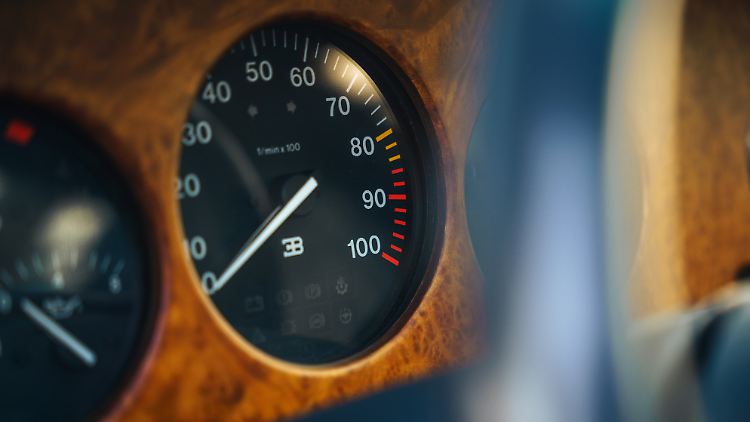

The twelve-cylinder engine, which was incredibly advanced for the time, turns at over 8000 rpm. No wonder, as it is designed for a short stroke with a bore and stroke ratio of 81 x 57 millimeters.
(Photo: Patrick Broich)
And after all the theory, I'm actually allowed to get behind the wheel here and now. I'm a little nervous because the high-tech V12 may have over 30,000 kilometers on the clock, but it's probably been standing still for most of its life, which isn't good for the technology. Is there anything that will break? The Selected Car Group team has already warmed up the three-and-a-half, which purrs elegantly rather than roars loudly. So I can try revving it up a bit later.
According to the briefing, the all-wheel drive vehicle with central viscous coupling is easy to drive and is not particularly fussy. Well, I don't want to test the limits here anyway, the specimen is too valuable. And since a colleague drives up first, I get out again after a short test drive and listen and watch the spectacle from the rear perspective while driving behind. The EB110 is alive, blowing a subtle smoky sound from the centrally arranged stove pipes when under load. It wants to be driven free. Long downtime, after all. Such expensive collector's vehicles are simply driven too rarely.
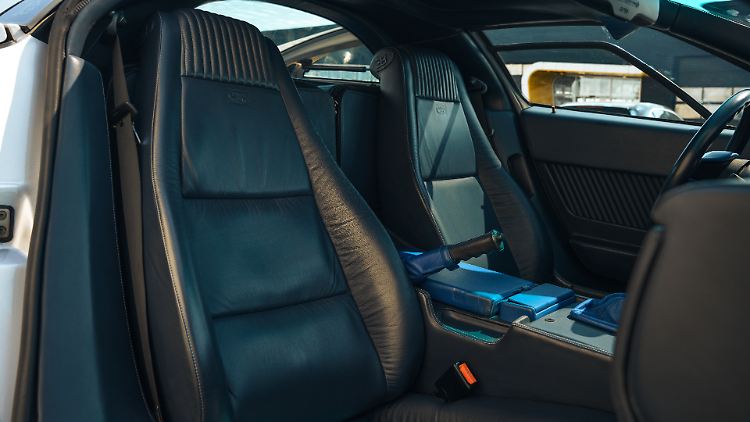

Is this supposed to be a sports car interior? Armchair-like seating is more reminiscent of a comfortable touring sedan.
(Photo: Patrick Broich)
Then finally my slot comes. I sink into the comfortable chair and instinctively press the clutch pedal, which is typically a little stiff. Since the transmission oil is nice and warm, the leather-covered gear lever engages fairly easily. And then it's straight onto the country road, which luckily isn't very busy. I get the twelve-cylinder engine, which is controlled by spur gears instead of a chain or toothed belt, rotating properly and wait for the explosive power development when the IHI chargers come into action. But no, it just doesn't happen. The 1.6-tonner pulls through fairly evenly and tightly, but not nearly as vigorously as expected.
You just get a bit jaded by today's sports cars with their absurd engine performance. And otherwise it drives quite unspectacularly, it could almost be used as an everyday car. If it weren't so confusing. And the seating position isn't quite as great either, and – typical of Italian cars – the pedals are close together.
The acceleration time to 100 km/h is supposed to be around 3.5 seconds. But the beast doesn't feel that fast. And it can also be driven smoothly and without jolting at low revs. If you rev it to full speed, the speedometer should show 200 km/h after 14 seconds. A 911 Carrera S can easily do that these days. Logically, I'm not going to rev the engine of the elderly athlete up to maximum revs. It just doesn't have to be that way.
Huge appearance
In addition, this exceptional Bugatti is a formidable sight even when driving slowly, with the front looking really cool with its huge rectangular headlights compared to the rear, which visually loses out to the front view. Imposing rollers of dimension 335/30 18 mounted on the BBS magnesium classics have a decisive influence on the effect the EB110 has on its surroundings.
Just one set of rims costs 25,000 euros. You don't even want to know how expensive an inspection will be. Replacing 15 liters of decentrally stored oil (dry sump lubrication) is a minor problem. And the Bugatti is also said to be quite a heavy drinker, and when driven appropriately, it will happily take 25 to 30 liters per 100 kilometers from the two-part 120-liter reservoir, as contemporary specialist media have noted.
Regardless, most Bugatti EB110s are only taken out of the garage on special occasions, if at all. This occasion was special too. After all, the media presence of an EB110 is almost as rare as the vehicle itself. The cars of the Selected Car Group can now also be admired in the Düsseldorf Classic Remise, where the Danes have a shop branch. And with a bit of luck, the EB110 discussed here or another one will also be there.



















